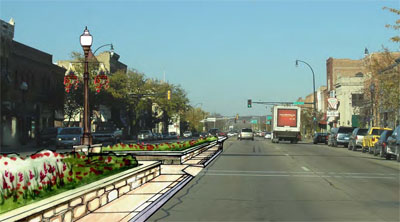By Nick Carpenter

Crews began work in early July on a $16.5-million, stimulus-funded project that aims to transform St. Peter’s main street, also known as Hwy 169 and Minnesota Avenue, into a safer corridor for pedestrians and motorists alike. Photo by Nick Carpenter |
If you have ever traveled Hwy 169 between the Twin Cities and Mankato, then you are likely familiar with the city of St. Peter.
Nestled in the Minnesota River Valley bluffs, St. Peter boasts a quaint environment complete with old world charm and rich history. In fact, a large portion of downtown is a designated National Historic District.
One thing St. Peter lacks that many other notable antique towns possess is a true pedestrian-friendly main street. That is, until now.
Crews began work in early July on a $16.5-million, stimulus-funded project that aims to transform St. Peter’s main street, also known as Hwy 169 and Minnesota Avenue, into a safer corridor for pedestrians and motorists alike.
Planning for the project began in 2002, when a group of 40 representatives from agencies and communities along the Hwy 169 corridor formed to assist Mn/DOT in the development of a corridor management plan.
Through discussions, the group determined that the dual uses of the highway as an interregional corridor and as a main street through an historic central business district were potentially in conflict. In the last three years alone, more than 100 crashes occurred on Hwy 169 through St. Peter. As a result, the group identified a variety of issues pertaining to safety and infrastructure.
“The combination of through traffic, local traffic and pedestrians was posing safety problems and operational difficulties at certain intersections,” said Matt Rottermond, project manager. “The safety features of the current project should take care of many of these issues.”
As part of the project, crews will install pedestrian bumpouts and crosswalks at intersections and construct raised medians that will provide a refuge for pedestrians crossing the street.
In addition to various safety issues, the project addresses issues with the pavement and municipal utilities under Hwy 169.
“The city utilities under the highway are very old,” Rottermond said. “Crews will replace sanitary sewer and water mains and improve the current storm sewer.”

An artist's rendering of the median and limestone planter wall between Nassau Street and Park Row Street. Courtesy of District 7 |
A District 7 first
The reconstruction of Hwy 169 through St. Peter is District 7’s first project using design-build, which is a contracting process that brings designers and contractors together early in the detail design portion of a project.
Instead of producing complete construction plans for a contractor to bid on, Mn/DOT and the city of St. Peter provided the preliminary design and project requirements to potential design-build teams, which were composed of a contractor and a design consultant. The teams then proposed an approach to accomplishing the design and construction within the constraints provided.
“Our close partnership with the city was key in our ability to move this complex project forward,” said Rottermond. “Thanks to St. Peter and the stimulus funding, we are able to complete this project at one time instead of in three or more seasons.”
The team with the best-value proposal, Shafer Contracting, Co., Inc., won the contract and is now responsible for completing the design on certain portions of the road while construction is occurring on other portions. The synchronized approach will ultimately allow for the project to be completed at a more time-efficient pace, which is welcoming news to local businesses.
"As with any major construction project, this one will cause some disruption,” said Rottermond. “The detour we have set up is working great, but I think it is in everyone’s best interest to get in, get all the work done and get out as quickly as possible.”
In addition, District 7 created an oversight committee to work with the design-build team and make sure that all previously identified standards are being met.
When completed in spring 2010, the reconstructed Hwy 169 is expected to have a lasting effect on the community.
“I think this project will benefit the city of St. Peter greatly,” said Rottermond. “This project will definitely beautify the entire downtown and hopefully make the city even more of a destination.”
For additional information on the St. Peter design-build project, visit http://www.dot.state.mn.us/d7/projects/169stpeter/index.html. |



